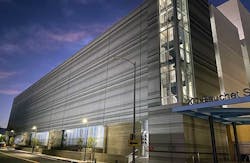In Latest Urban Greenfield Project, CoreSite Opens LA3 Data Center
CoreSite has deep roots in Los Angeles, where it launched its data center business at One Wilshire in 2001. Operating the Meet-Me Room of the iconic West Coast Internet hub provided the CoreSite team with early expertise in interconnection and urban data center development that would define its approach for years to come.
CoreSite’s L.A. story continues with this week’s opening of LA3, a 160,000 square foot data center in the heart of downtown Los Angeles, adjacent to its LA2 facility. The first phase offers 51,000 square feet of space and six megawatts of capacity, with additional phases to expand up to 18 megawatts. About 4.5 megawatts of the first phase is pre-leased to a customer.
LA3 is the city’s first purpose built data center, designed from the ground up as a for storing and delivering data. Downtown Los Angeles has been a retrofit market, with developers creating data centers within buildings that were previously used for other purposes. One Wilshire was initially an office tower, while CoreSite LA2 was built in the Terminal Annex, a former U.S. Post Office facility that for many years was the processing center for the city’s mail.
“LA3 expands our footprint in Los Angeles – one of our most high-demand markets – expanding our world-class ecosystem connectivity,” says Brian Warren, CoreSite’s Senior Vice President of Development and Product Engineering. “We believe this enterprise-class, purpose built, ground-up development will be extremely well suited to meet our customers’ needs.”
CoreSite’s three Los Angeles sites form a campus connected by high-density dark-fiber, populated by more than 670 networks, cloud and enterprise customers.
The LA3 project is part of a larger building program for CoreSite. Over the past 18 months, CoreSite has launched construction projects across the country to add capacity to meet surging demand for colocation and interconnection services.
CoreSite specializes in projects in major urban centers, where construction timelines are complicated and deploying new space can require patience. As a result, CoreSite has been managing simultaneous data center construction projects in Chicago, Los Angeles, Silicon Valley, Northern Virginia, and Northern New Jersey.
About the Author



